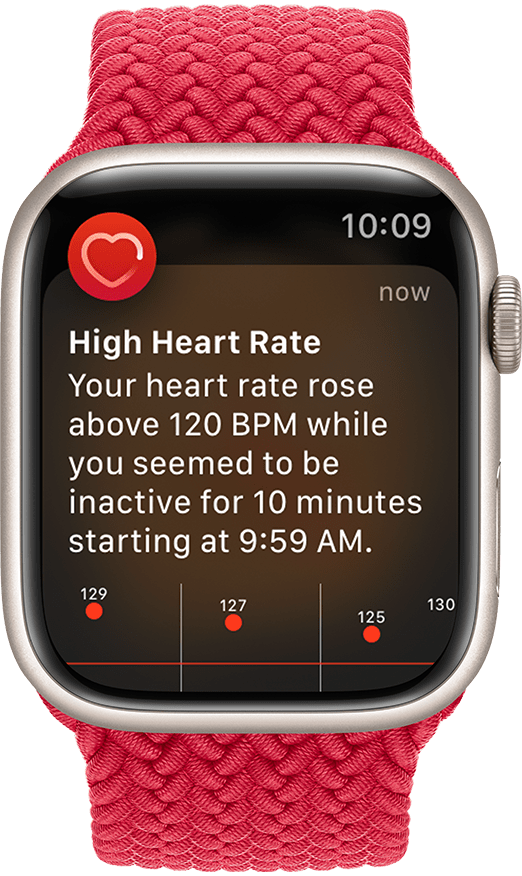Heart health notifications on your Apple Watch
You can enable notifications from the Heart Rate app on your Apple Watch to alert you about high or low heart rates and irregular heart rhythms that have been detected.
High and low heart rate notifications
If your heart rate remains above or below a chosen beats per minute (BPM), your Apple Watch can notify you. These notifications are only available on Apple Watch Series 1 or later, and for people aged 13 and above.
You can turn on heart rate notifications when you first open the Heart Rate app on your Apple Watch, or at any time after this from your iPhone:
On your iPhone, open the Apple Watch app.
Tap the My Watch tab, then tap Heart.
Tap High Heart Rate, then choose a BPM.
Tap Low Heart Rate, then choose a BPM.

Irregular rhythm notifications
The irregular rhythm notification feature on your Apple Watch will occasionally look at your heartbeat to check for an irregular rhythm that may be suggestive of atrial fibrillation (Afib). Find out how to enable irregular rhythm notifications. Irregular rhythm notifications are currently only available in certain countries and regions. You can also find your version of the irregular rhythm notification feature.
Here's what you'll need to enable irregular rhythm notifications
Make sure that notifications are available in your country or region. Find out where irregular rhythm notifications are available.
Update your iPhone to the latest version of iOS and Apple Watch to the latest version of watchOS.
These notifications are not designed to be used by people who have been diagnosed with Afib.
These notifications are not intended to be used by people under the age of 22.
Afib History must not be enabled.
How to enable irregular rhythm notifications
Make sure that the software on your iPhone and Apple Watch is up to date.
On your iPhone, open the Health app.
Tap the Browse tab, then go to Heart > Irregular Rhythm Notifications.
Once enabled, you can turn irregular rhythm notifications on or off in the Apple Watch app on your iPhone: Open the Apple Watch app, tap the My Watch tab, then go to Heart > Irregular Rhythm.

What to do when you receive an alert
If you receive a notification, then the irregular rhythm notification feature on your Apple Watch has identified an irregular rhythm that's suggestive of Afib and has confirmed it with multiple readings.
If you have not previously been diagnosed with Afib, you should talk to your doctor. If you have been diagnosed with Afib, find out how you can track your Afib History on Apple Watch.
How irregular rhythm notifications work
The irregular rhythm notification feature on your Apple Watch will occasionally look at your heartbeat to check for an irregular rhythm that may be indicative of Afib. This usually happens when you're not moving to ensure a more accurate reading. Depending on how active you are, the number of readings collected each day and the time between these readings will vary.
About Afib
Afib is a type of irregular heart rhythm where the upper chambers of the heart beat out of sync with the lower chambers.
According to the CDC, approximately 2% of people under the age of 65 and 9% of people aged 65 and older have Afib. Irregularities in heart rhythm become more common as people get older. Some individuals with Afib don't experience any symptoms. Others experience symptoms such as a rapid heartbeat, palpitations, fatigue or shortness of breath.
Afib is a chronic condition, but the amount of time people spend in Afib can change. People with Afib often live healthy, active lives. The amount of time your heart is in Afib can potentially be reduced with regular physical activity, a heart-healthy diet, a healthy weight and treatment of other medical conditions that could worsen Afib. If left untreated, Afib can lead to heart failure or blood clots that may lead to stroke. Afib can be managed with a doctor's care and medication, and early diagnosis and treatment can prevent such complications.
Things you should know
If Low Power Mode is turned on, you won't receive any high or low heart rate or irregular rhythm notifications. Find out more about Low Power Mode.
Apple Watch cannot detect heart attacks. If you ever experience chest pain, pressure, tightness or what you think is a heart attack, call the emergency services immediately.
The irregular rhythm notification feature on Apple Watch is not constantly looking for Afib. This means it cannot detect all instances of Afib, and people with Afib may not receive a notification.
If you're not feeling well, you should talk to your doctor even if you haven't received a notification. Symptoms such as a rapid, pounding or fluttering heartbeat, dizziness or fainting can be indicative of a serious condition.
Do not change your medication without talking to your doctor.
In some instances, the notification may indicate the presence of an irregular heart rhythm that's not Afib.